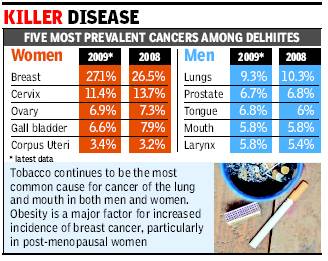Healthcare and public health: Delhi
This is a collection of articles archived for the excellence of their content. Readers will be able to edit existing articles and post new articles directly |
Contents |
Cancer: Delhi
Breast cancer on rise, exercise can cut risk
Durgesh Nandan Jha TNN
The Times of India 2013/08/14
New Delhi: Breast cancer continues to keep its grip on the capital with more city women falling prey to the disease every passing year. Indian Council of Medical Research’s latest data shows an increase of 0.6 percent over the worrisome figure of 26.5 percent recorded previously.
Dr P K Julka, who heads the Delhi Cancer Registry, said the trend reflects how awareness is still missing on prevention and management of the disease. “Obesity is a major cause for breast cancer in post-menopausal women. It leads to excessive production of female hormones,” he said. Julka added that healthy diet and regular exercise can go a long way in preventing incidence of breast cancer.
According to the latest data collected from 168 major government hospitals, 250 private hospitals and municipal bodies, Delhi recorded 15,244 cancer cases in 2009. Among them, 8,122 (53.3%) were men and 7,122 (46.7%) were women. “In both men and women, the number of new cancers was more in the middle age group (35-64 years). In children, cancer cases were more in boys (5.7%) compared to girls (3.2%),” added Julka, professor of radiation oncology at AIIMS. He said that cervical cancer cases have, however, gone down significantly as part of a general trend “owing to awareness, better genital hygiene and HPV vaccination”.
As far as tobacco-related cancers are concerned, incidence is high among men. Two in every five cases of cancer among men in Delhi is due to tobacco. Mortality rate was recorded at 10.6 per 1,00,000 men and 9.4 per 1,00,000 women. “Most cancer patients diagnosed in initial stages can be saved. But due to lack of awareness and regular health screening practices, patients come to us late,” Dr G K Rath, chief of BRA Institute Rotary Cancer Hospital, said.
Dengue and Delhi
Dengue cloud over capital
Durgesh Nandan Jha TNN
The Times of India 2013/08/13
Dengue fever is the viral disease which is caused by the bite of the Aedes aegypt i mosquito. The total number of dengue cases reported in Jan-August 2013 at 41 is more than the count reported in corresponding figures for the previous two years. Delhi reported only 10 dengue cases in 2012, but in 2011, 38 cases were reported till August 10.
The data received also shows that a majority of patients diagnosed with dengue are below 40 years of age.
“The incidence of mosquito breeding has increased alarmingly in the last two weeks due to continuous rains and stagnation of fresh water,” said a senior municipal corporation official. He said 53 cases of malaria and four cases of chikungunya have been reported so far this year. Dr N K Yadav, the municipal health officer, added dengue breeding checkers are visiting all households to make residents aware of best practices.
“The symptoms are common for all viral illnesses. But dengue is characterized by high fever, pain in the eyes, rashes, nausea and vomiting. In some cases, there could be severe drop in platelet count and bleeding from the nose or gums which is reflective of the severity of the case,” said Dr Romel Tickoo, senior consultant internal medicine at Max Hospital, Saket. He said that certain painkillers are known to cause sudden decrease in platelet count and so they must be avoided.
2014-15
The Times of India, Jun 25 2015

DurgeshNandan Jha
City lags behind Kerala, TN on health indicators
Delhi remains behind states like Kerala and Tamil Nadu in key health indicators, such as the infant mortality rate (IMR). The Eco nomic Survey report 2014-15 shows that 22 of every 1,000 children born in the city in 2013 the latest available data) died within a year of birth. The number of children dy ng within 29 days of birth--al so called neonatal mortality rate (NMR)-stood at 15 per 1,000 births for the correspond ing year, as per the civil regis tration system.
Dr V K Paul, professor and head of the pediatrics depart ment at AIIMS, said the figures reflected lack of infrastruc ture. “Kerala and Tamil Nadu fare much better in terms of IMR despite having a larger and more diverse population Tamil Nadu has tribal and coastal populations that are un educated,“ he said.
Dr Paul added that neonatal ICU facilities in Delhi need to be increased and mothers need to be made aware about the best practices. Dr Krishan Chugh chairman of the department of paediatrics at Sir Ganga Ram Hospital, said the institutional birth rate has gone up in Delhi “Deaths are still happening due to poor ante-natal care, and in some cases mothers reach hos pital for birth too late,“ he said.
The report shows that the percentage of gross state do mestic product (GSDP) spent on healthcare in Delhi has re duced from 1.05 in 2006-07 to 0.96 in 2014-15. In 2001, Delhi's IMR was 24 per 1,000 births. It re duced to 13 per 1,000 in 2004 and 2005 but has been on the rise ev er since. Delhi's NMR was 14 per 1,000 in 2001 and reduced to 9 per 1,000 in 2004 but has been increasing ever since.
Experts said conditions arising in the period immedi ately before and after birth cause maximum infant deaths followed by hypoxia, birth as phyxia and other respiratory conditions. “The government is promoting institutional childbirth but the infrastruc ture required for it remains poor. Infection rates are high in most maternity centres due to poor hygiene. The number of doctors and nurses is also not adequate,“ said an expert.

